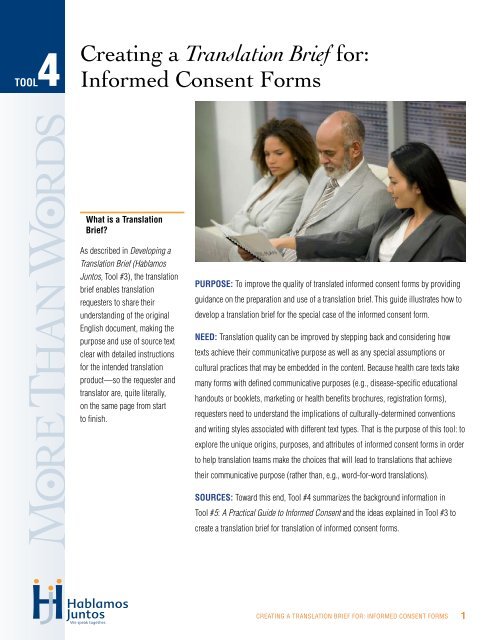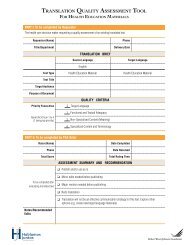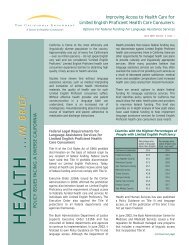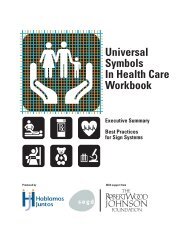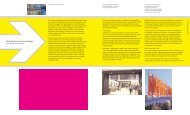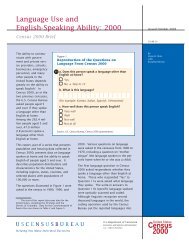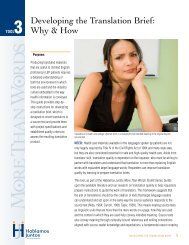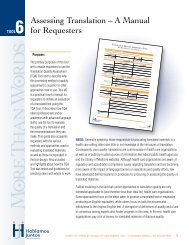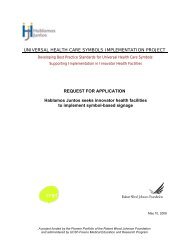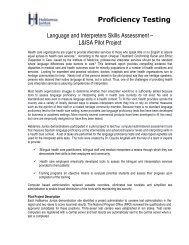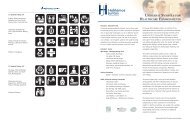Creating a Translation Brief for: Informed ... - Hablamos Juntos
Creating a Translation Brief for: Informed ... - Hablamos Juntos
Creating a Translation Brief for: Informed ... - Hablamos Juntos
You also want an ePaper? Increase the reach of your titles
YUMPU automatically turns print PDFs into web optimized ePapers that Google loves.
Tool4<br />
<strong>Creating</strong> a <strong>Translation</strong> <strong>Brief</strong> <strong>for</strong>:<br />
In<strong>for</strong>med Consent Forms<br />
MORE THAN WORDS<br />
What is a <strong>Translation</strong><br />
<strong>Brief</strong><br />
As described in Developing a<br />
<strong>Translation</strong> <strong>Brief</strong> (<strong>Hablamos</strong><br />
<strong>Juntos</strong>, Tool #3), the translation<br />
brief enables translation<br />
requesters to share their<br />
understanding of the original<br />
English document, making the<br />
purpose and use of source text<br />
clear with detailed instructions<br />
<strong>for</strong> the intended translation<br />
product—so the requester and<br />
translator are, quite literally,<br />
on the same page from start<br />
to finish.<br />
Purpose: To improve the quality of translated in<strong>for</strong>med consent <strong>for</strong>ms by providing<br />
guidance on the preparation and use of a translation brief. This guide illustrates how to<br />
develop a translation brief <strong>for</strong> the special case of the in<strong>for</strong>med consent <strong>for</strong>m.<br />
Need: <strong>Translation</strong> quality can be improved by stepping back and considering how<br />
texts achieve their communicative purpose as well as any special assumptions or<br />
cultural practices that may be embedded in the content. Because health care texts take<br />
many <strong>for</strong>ms with defined communicative purposes (e.g., disease-specific educational<br />
handouts or booklets, marketing or health benefits brochures, registration <strong>for</strong>ms),<br />
requesters need to understand the implications of culturally-determined conventions<br />
and writing styles associated with different text types. That is the purpose of this tool: to<br />
explore the unique origins, purposes, and attributes of in<strong>for</strong>med consent <strong>for</strong>ms in order<br />
to help translation teams make the choices that will lead to translations that achieve<br />
their communicative purpose (rather than, e.g., word-<strong>for</strong>-word translations).<br />
Sources: Toward this end, Tool #4 summarizes the background in<strong>for</strong>mation in<br />
Tool #5: A Practical Guide to In<strong>for</strong>med Consent and the ideas explained in Tool #3 to<br />
create a translation brief <strong>for</strong> translation of in<strong>for</strong>med consent <strong>for</strong>ms.<br />
<strong>Creating</strong> a <strong>Translation</strong> <strong>Brief</strong> <strong>for</strong>: In<strong>for</strong>med Consent Forms 1
Tool4<br />
Tool #4 synthesizes the concepts found in two other publications in the More Than Words<br />
Toolkit Series to illustrate how translation briefs can be created <strong>for</strong> in<strong>for</strong>med consent<br />
<strong>for</strong>ms—a specific source text type.<br />
Who Should Use This Guide:<br />
This guide is meant <strong>for</strong> requesters or individuals (or departments or organizations)<br />
responsible <strong>for</strong> initiating translations of in<strong>for</strong>med consent <strong>for</strong>ms. In some cases, it may<br />
be used by the original author(s) or the translator to initiate discussion with the person(s)<br />
requesting the translation.<br />
How to Use This Tool:<br />
Section 1: Understanding In<strong>for</strong>med Consent Forms<br />
Start by reading Section 1 which describes the in<strong>for</strong>med consent <strong>for</strong>m, its medical<br />
and legal attributes and the special challenges this unique text type presents to health<br />
organizations and <strong>for</strong> producing translations.<br />
Section 2: How to Develop <strong>Translation</strong> <strong>Brief</strong> <strong>for</strong> In<strong>for</strong>med Consent Forms<br />
Next, examine the step-by-step instructions and examples in Section 2 to understand how<br />
one should develop a translation brief <strong>for</strong> consent <strong>for</strong>ms. This goes through the steps of<br />
developing a translation brief, applied to the special case of the in<strong>for</strong>med consent <strong>for</strong>m.<br />
This includes gathering in<strong>for</strong>mation about the purpose and unique function of consent<br />
<strong>for</strong>ms, evaluating the quality of source text and comparing and contrasting the source and<br />
target audiences to develop instructions <strong>for</strong> translating the consent <strong>for</strong>m.<br />
<strong>Creating</strong> a <strong>Translation</strong> <strong>Brief</strong> <strong>for</strong>: In<strong>for</strong>med Consent Forms 2
Tool4<br />
“<br />
The in<strong>for</strong>med consent <strong>for</strong>m<br />
<strong>for</strong>malizes communication between<br />
a patient and physician and<br />
concludes with the patient’s in<strong>for</strong>med<br />
authorization to undergo a medical<br />
intervention.<br />
“<br />
Understanding In<strong>for</strong>med Consent Forms<br />
The in<strong>for</strong>med consent <strong>for</strong>m <strong>for</strong>malizes communication between a patient and physician<br />
and concludes with the patient’s in<strong>for</strong>med authorization to undergo a medical intervention.<br />
For medical, ethical and legal reasons, patients must be given enough in<strong>for</strong>mation to be<br />
fully in<strong>for</strong>med be<strong>for</strong>e deciding to undergo a major treatment and their in<strong>for</strong>med consent<br />
must be verified in writing. In most U.S. institutions today, a signature on a consent <strong>for</strong>m<br />
is required <strong>for</strong> surgery, anesthesia and other invasive or complex medical or radiologic<br />
procedures (although the exact requirements vary from state to state and institution to<br />
institution). A signed consent <strong>for</strong>m attests to an exchange of in<strong>for</strong>mation that represents an<br />
in<strong>for</strong>med consent. The in<strong>for</strong>med consent <strong>for</strong>m as a text type is unique to Western medicine<br />
and does not always have an equivalent in other languages and cultures, which is why<br />
translations of such documents is difficult yet very important.<br />
The Fundamental Problem: In<strong>for</strong>med Consent<br />
is Difficult to Do Well in English<br />
Un<strong>for</strong>tunately, even after signing a consent <strong>for</strong>m, many patients still do not understand all<br />
of the risks and benefits of their proposed treatment choices. The Joint Commission, the<br />
accreditation agency <strong>for</strong> most health facilities in the U.S. has found that among patients<br />
who sign a consent <strong>for</strong>m, 60 to 70 percent do not read or understand the in<strong>for</strong>mation<br />
contained on the <strong>for</strong>m. Even many native speakers of English struggle to make sense of<br />
the medical and legal content of consent <strong>for</strong>ms. This gap between the ideal function of the<br />
in<strong>for</strong>med consent <strong>for</strong>m process and everyday reality increases the risk <strong>for</strong> medical errors,<br />
safety breakdowns and malpractice claims. Foreign language and cultural differences add<br />
yet another hurdle to an already difficult task.<br />
In<strong>for</strong>med Consent: From Ideal… to Reality… to Practical Solutions<br />
Required Elements or Goals<br />
Signed <strong>for</strong>m indicating patient wants<br />
treatment and understands:<br />
›› Diagnosis/condition<br />
›› Nature/purpose of treatment<br />
›› Risks/benefits of treatment<br />
›› Alternatives<br />
›› Risks/benefits of alternatives<br />
›› Risks/benefits of no treatment plus<br />
doctor statement that the patient<br />
understands and statement (as needed)<br />
that an interpreter provided services<br />
Barriers<br />
Patient factors:<br />
›› Low health care literacy<br />
›› Limited English proficiency (LEP)<br />
›› Intimidation/stress<br />
›› Confusion about the consent process<br />
Provider factors:<br />
›› Time limitations<br />
›› Complex <strong>for</strong>ms/language<br />
›› Lack of interpreters and/or<br />
translated <strong>for</strong>ms<br />
›› Wrong assumptions re: patient<br />
comprehension<br />
Best Practices<br />
Form Simplicity:<br />
›› Design/layout<br />
›› Word choice<br />
›› Readability<br />
Message Tailoring:<br />
›› Discuss with patient<br />
›› Allow time <strong>for</strong> Q+A<br />
›› Use “teach back” to ensure patient<br />
comprehension<br />
›› Use the language of the patient<br />
<strong>Creating</strong> a <strong>Translation</strong> <strong>Brief</strong> <strong>for</strong>: In<strong>for</strong>med Consent Forms 3
Tool4<br />
Several best practices have been suggested to guide communication between patients and<br />
physicians to improve the effectiveness of obtaining in<strong>for</strong>med consent. Presumably, these<br />
best practices are also adopted <strong>for</strong> limited English proficiency (LEP) patients, although<br />
preparing a translation brief <strong>for</strong> an in<strong>for</strong>med consent <strong>for</strong>m project is an opportunity to<br />
determine how well this ideal holds up. Some health care organizations and systems, in<br />
an attempt to service the needs of low literacy populations, have also successfully applied<br />
standards <strong>for</strong> <strong>for</strong>mat and readability of their consent <strong>for</strong>ms. The procedural consent <strong>for</strong>ms<br />
from the Queensland Government of Australia are considered a model of simplicity,<br />
consistency and effectiveness. They even go one step further by anticipating cross-cultural<br />
encounters and the use of interpreters. On these <strong>for</strong>ms, interpreters must also sign the<br />
consent <strong>for</strong>m when they are involved.<br />
Research done by <strong>Hablamos</strong> <strong>Juntos</strong> and others indicate that most English consent <strong>for</strong>ms<br />
today are still too complex and legalistic or (as with generic fill-in-the-blank <strong>for</strong>ms) too nonspecific.<br />
The challenge of producing easier-to-read in<strong>for</strong>med consent <strong>for</strong>ms in English and<br />
ideas <strong>for</strong> practical solutions are the focus of A Practical Guide to In<strong>for</strong>med Consent – Tool #5<br />
of the More Than Words Toolkit Series and a companion to this guide.<br />
“<br />
Research done by <strong>Hablamos</strong> <strong>Juntos</strong><br />
and others indicate that most<br />
English consent <strong>for</strong>ms today are<br />
still too complex and legalistic or<br />
(as with generic fill-in-the-blank<br />
<strong>for</strong>ms) too non-specific.<br />
“<br />
The Need <strong>for</strong> Translated Consent Forms<br />
The inability to speak English well is widely recognized as a major cause of failed<br />
communication in obtaining in<strong>for</strong>med consent and in other health care communications.<br />
This explains why many health care organizations employ interpreters to enable discussion<br />
of treatment options and/or to sight translate English consent <strong>for</strong>ms (sight translation<br />
is verbal translation or oral interpretation of a written text, often without any preparation<br />
time). In fact, a variety of state laws, federal policies (e.g., Title VI of the Civil Rights Act<br />
of 1964, Office of Minority Health CLAS standards) and accreditation standards (e.g.,<br />
The Joint Commission, Health Insurance Portability and Accountability Act, National<br />
Committee <strong>for</strong> Quality Assurance) now require health care organizations to ensure all<br />
important documents <strong>for</strong> LEP patients are culturally and linguistically appropriate. More<br />
specifically, the U.S. government in Executive Order 13166 requires that in<strong>for</strong>med consent<br />
<strong>for</strong>ms be translated into languages spoken by at least 5% or 1,000 of a provider’s patients,<br />
whichever is less/fewer.<br />
Within the health care industry, untrained or inadequately-prepared translators are a<br />
primary source of health materials translations. Working with health care organizations in<br />
10 states, <strong>Hablamos</strong> <strong>Juntos</strong> has found that producing non-English in<strong>for</strong>med consent <strong>for</strong>ms<br />
is typically a struggle <strong>for</strong> health care organizations. As with the English versions of these<br />
<strong>for</strong>ms, there is a gap between the ideal and reality.<br />
<strong>Creating</strong> a <strong>Translation</strong> <strong>Brief</strong> <strong>for</strong>: In<strong>for</strong>med Consent Forms 4
Tool4<br />
Queensland In<strong>for</strong>med Consent<br />
Form Elements<br />
›› Interpreter/Cultural Needs<br />
›› Condition and Procedure<br />
›› Anesthesia<br />
›› General Risks of Procedure<br />
›› Risks of this Procedure<br />
›› Significant Risks and Relevant<br />
Treatment Option<br />
Signatures Required of the:<br />
›› Patient<br />
›› Interpreter—if one is involved<br />
›› Doctor per<strong>for</strong>ming the procedure<br />
In some cases, the problem can be traced directly to the poor quality of the English<br />
version. However, even when the source consent <strong>for</strong>m is exemplary, the translated<br />
versions often are difficult to read, even <strong>for</strong> target audiences with high literacy skills. These<br />
difficulties may involve not only practical limitations in budgets and poor translation<br />
planning and review, but also technical challenges such as a scarcity of staff experienced<br />
in commissioning translations. Tool #3 discusses common obstacles requesters face,<br />
including the challenge of distinguishing high-quality translations from low-quality<br />
translations. As a result, low-quality translations are common: they not only contain errors<br />
in grammar, spelling and vocabulary, but also have problems of over-literalism (i.e., strict<br />
word-<strong>for</strong>-word translation) that obscure the original intent and neglects cultural nuance.<br />
Current quality measures such as back-translation into English are not effective as the<br />
Example of Word-<strong>for</strong>-Word <strong>Translation</strong> shows. What may look correct in English<br />
belies awkward, unnatural translation in a target language.<br />
Example of Word-<strong>for</strong>-Word <strong>Translation</strong><br />
Source: You CANNOT get TB from…<br />
<strong>Translation</strong>: …<br />
Back translation: You cannot get TB from<br />
Result: Very awkward Chinese, but difficult<br />
to appreciate <strong>for</strong> those unfamiliar<br />
with the language<br />
(Refugee Health In<strong>for</strong>mation Network, 2009)<br />
<strong>Creating</strong> a <strong>Translation</strong> <strong>Brief</strong> <strong>for</strong>: In<strong>for</strong>med Consent Forms 5
Tool4<br />
Content<br />
Context<br />
Consent<br />
The New Challenge <strong>for</strong> Translators: Context and<br />
Content in In<strong>for</strong>med Consent<br />
Assuming <strong>for</strong> a moment the availability of a high-quality source consent text and the<br />
involvement of competent translation professionals, what else would be needed to produce<br />
a high-quality translation of an in<strong>for</strong>med consent <strong>for</strong>m At <strong>Hablamos</strong> <strong>Juntos</strong>, we believe<br />
the extra challenge involves disabusing the commonly-held view that the objective of a<br />
translation project is to produce an equivalent target text. The notion of equivalence is a<br />
vague and often controversial term subject to numerous interpretations. Every language<br />
is a unique <strong>for</strong>m of communication shaped by underlying cultural practices, values and<br />
beliefs. The conventions and elements of a text (e.g., title, tone, writing voice) are dictated<br />
by cultural norms associated with the <strong>for</strong>m and purpose of communication. This is why<br />
word-<strong>for</strong>-word renditions of English are often not possible and why approximations of an<br />
English text, or faithfulness to the intended meaning of a source text, are more appropriate.<br />
Example of Meaning-<strong>for</strong>-Meaning <strong>Translation</strong> 3<br />
…Concepts that overlap<br />
and must be considered together<br />
Source:<br />
<strong>Translation</strong>:<br />
cool, pale skin, cold hands and feet<br />
<br />
Meaning translation: Skin [is] pale cool hands feet ice cold<br />
The change of the grammatical structure in the meaning-<strong>for</strong>-meaning translation makes<br />
<strong>for</strong> more natural and idiomatically correct Chinese without losing the intended meaning.<br />
The difference is significant to the Chinese reader.<br />
(Health In<strong>for</strong>mation <strong>Translation</strong>s, 2009)<br />
Without an understanding of a source texts use, purpose and goal, even translations<br />
produced by well-trained translators may not be useful to target audience. The<br />
consequences of low-quality translations can be dire <strong>for</strong> LEP patients who are on the<br />
cusp of making important, often life-changing, health care decisions. Some translation<br />
guidelines now emphasize that translations should be measured against criteria agreed<br />
upon in advance. The broader purpose and the unstated assumptions (often culturally<br />
determined) embedded in a specific type of text need to be identified and the implications<br />
<strong>for</strong> a target text need to be considered (ISO 9000:2000, ASTM International F-2575-06<br />
2006). With this approach, the scope of translation requires looking beyond a faithful<br />
word-<strong>for</strong>-word translation. Explicitly setting criteria is essential to permitting translators<br />
to navigate within a specified degree of variation and subjectivity. In<strong>for</strong>med consent <strong>for</strong>ms<br />
have legally-defined requirements often not stated on the <strong>for</strong>m itself. Translators need<br />
specific guidance to pursue a meaning-<strong>for</strong>-meaning translation, so the contextual elements<br />
that are deeply embedded within the in<strong>for</strong>med consent <strong>for</strong>m need to be made clear. Without<br />
this type of guidance, the outcome can be translations that are even less understandable in<br />
the target language.<br />
As discussed next, the translation brief is a tool designed to convey such guidance.<br />
<strong>Creating</strong> a <strong>Translation</strong> <strong>Brief</strong> <strong>for</strong>: In<strong>for</strong>med Consent Forms 6
Tool4<br />
How to Develop <strong>Translation</strong> <strong>Brief</strong>s <strong>for</strong> In<strong>for</strong>med Consent Forms<br />
In this guide, the key steps <strong>for</strong> creating a translation brief <strong>for</strong> in<strong>for</strong>med consent <strong>for</strong>ms are<br />
summarized. These instructions use the framework provided in Developing a <strong>Translation</strong> <strong>Brief</strong><br />
(Tool #3), with a focus specifically on the in<strong>for</strong>med consent <strong>for</strong>m. These four steps provide an<br />
organized means of thinking about a consent <strong>for</strong>m translation project, help one develop clear<br />
specifications <strong>for</strong> a translator, and in some cases, cause one to rethink the project all together.<br />
Step 1: Gather in<strong>for</strong>mation about the function, overall purpose and end use of the<br />
source in<strong>for</strong>med consent <strong>for</strong>m. Learn about the source <strong>for</strong>m and how it is used with the<br />
source audience.<br />
Step 2: Evaluate the quality of the source <strong>for</strong>m to make a GO / NO-GO decision.<br />
Poor-quality source texts hinder the production of useful translations.<br />
“<br />
Preparing a translation brief,<br />
closely analyzing the source text,<br />
and comparing and contrasting<br />
source and target audiences can<br />
help identity potential roadblocks<br />
if the source consent <strong>for</strong>m does not<br />
represent a good starting point.<br />
“<br />
Step 3: Compare and contrast the relevant aspects of the source and target audiences to<br />
identify implications <strong>for</strong> the target <strong>for</strong>m. Analyze the content of the source <strong>for</strong>m to identify<br />
any evidence of source culture bias that will need to be replaced by target culture<br />
conventions, as well as translation challenges that will need to be overcome, including<br />
production challenges.<br />
Step 4: Summarize specific needs and special requirements <strong>for</strong> the translator. These<br />
specifications will become the benchmarks to assess the quality of a translation product.<br />
When developing a translation brief <strong>for</strong> an in<strong>for</strong>med consent <strong>for</strong>m, two concerns unique<br />
to this text type need to be considered at every stage of the process. First, because of<br />
the potentially high-stake legal and clinical consequences associated with the use of an<br />
in<strong>for</strong>med consent <strong>for</strong>m, requesters need to recognize that unlike other text types (e.g.,<br />
health education materials), there may not be much flexibility in what in<strong>for</strong>mation is<br />
presented. Understanding the intended meaning is critical to creating translations that<br />
meet their intended objective of in<strong>for</strong>med consent. Second, <strong>for</strong> precisely the same reasons<br />
just cited, it is crucial that translation products support in<strong>for</strong>med decision-making by the<br />
patient as well as satisfy physician and institutional responsibility <strong>for</strong> full disclosure. To<br />
this end, translated consent <strong>for</strong>ms must capture the full original intent of the source text in<br />
a way that target audiences can understand.<br />
A fundamental goal of Tool #4 is to make sure that the communicative goal of in<strong>for</strong>med<br />
consent <strong>for</strong>ms are met by all translations. Preparing a translation brief, closely analyzing<br />
the source text, and comparing and contrasting source and target audiences can help<br />
identity potential roadblocks if the source consent <strong>for</strong>m does not represent a good starting<br />
point. In<strong>for</strong>med consent <strong>for</strong>ms written in heavily-legal or medical terms, even if translated<br />
by translators knowledgeable in the legal or medical fields, may not be easily understood<br />
by target audiences. Requesters can weigh this possible result to make a decision about<br />
whether to proceed with a translation project or to explore alternatives such as improving<br />
the source in<strong>for</strong>med consent <strong>for</strong>m or developing capacity <strong>for</strong> sight translation of consent<br />
<strong>for</strong>ms <strong>for</strong> LEP patients.<br />
<strong>Creating</strong> a <strong>Translation</strong> <strong>Brief</strong> <strong>for</strong>: In<strong>for</strong>med Consent Forms 7
Tool4<br />
Pre-<strong>Translation</strong> Analysis<br />
For most experienced translators, pretranslation<br />
analysis is often second nature<br />
and a highly-refined analytical process of<br />
studying the source language text. Good<br />
translators also know that the purpose and<br />
use of a text in its natural environment are<br />
essential to understand be<strong>for</strong>e undertaking<br />
a translation. The translation brief makes<br />
these critical elements clear, eliminating<br />
guess work, incomplete in<strong>for</strong>mation or<br />
incorrect assumptions.<br />
Step 1: Gather In<strong>for</strong>mation about the Source In<strong>for</strong>med<br />
Consent Form, Its Overall Purpose and Use<br />
The essence of a translation brief is to describe the purpose and use of a text by making<br />
clear the function of the text, the intended audience and how the text is introduced to its<br />
reader. The text function, overall purpose and use of in<strong>for</strong>med consent <strong>for</strong>ms are<br />
established in law and represent the culmination of a process of communication between<br />
a patient and physician, leading to the patient’s authorization to undergo a specific medical<br />
intervention (American Medical Association, 1998). The content of in<strong>for</strong>med consent<br />
<strong>for</strong>ms (explaining the condition and proposed treatment, general risks and benefits of<br />
the procedure, and treatment alternatives) pose significant challenges <strong>for</strong> translation,<br />
particularly <strong>for</strong> target audiences where the concepts embedded in the in<strong>for</strong>med consent<br />
process may not exist.<br />
Be<strong>for</strong>e proceeding with a full evaluation of the source in<strong>for</strong>med consent <strong>for</strong>m, ensure that<br />
the document is indeed an in<strong>for</strong>med consent <strong>for</strong>m (the “text type”) and that its purpose is<br />
to document the patient’s approval to move ahead with a test, procedure, surgery or other<br />
significant medical event.<br />
What is the purpose and use of an in<strong>for</strong>med consent <strong>for</strong>m<br />
For both ethical and legal reasons, patients must be given enough in<strong>for</strong>mation to become<br />
fully in<strong>for</strong>med be<strong>for</strong>e deciding to undergo a major treatment. The in<strong>for</strong>med consent <strong>for</strong>m is<br />
designed to document essential in<strong>for</strong>mation that must be given to a patient in making this<br />
decision. The content represents carefully-considered wording approved by the physicians<br />
per<strong>for</strong>ming these services, legal counsel and risk managers. Whatever the reason, the<br />
consequences of ill-in<strong>for</strong>med consent can be serious. Beyond the fundamental breach<br />
of ethical and legal duties to in<strong>for</strong>m the patient, there is also the increased potential <strong>for</strong><br />
medical errors and malpractice claims.<br />
When a request <strong>for</strong> translation is first received, the source in<strong>for</strong>med consent <strong>for</strong>m should<br />
be evaluated on a global level to understand its exact purpose. In this case, in<strong>for</strong>med<br />
consent is an ethical concept that all patients should understand and agree to the<br />
potential consequences of their care. This principle has become codified in law and in<br />
daily practice at every U.S. medical institution. One of the earliest legal precedents in this<br />
area was established in 1914 when a physician removed a tumor from the abdomen of a<br />
patient who had consented to only a diagnostic procedure (Schloendorff vs. Society of<br />
New York Hospital). The judge ruled that the physician was liable <strong>for</strong> battery because he<br />
violated an “individual’s fundamental right to decide what is being done with his or her<br />
body” (Edwards, Lil<strong>for</strong>d, Thornton and Hewison, 2005). The first case actually defining<br />
the elements of in<strong>for</strong>med consent occurred in the late 1950s and involved a question of<br />
potential negligence and whether a patient was given sufficient in<strong>for</strong>mation to make a<br />
decision. The case law and rules pertaining to in<strong>for</strong>med consent have changed over the<br />
years and all 50 states now have legislation that requires some level of in<strong>for</strong>med consent<br />
<strong>Creating</strong> a <strong>Translation</strong> <strong>Brief</strong> <strong>for</strong>: In<strong>for</strong>med Consent Forms 8
Tool4<br />
(Pape, 1997). Although the details of these laws vary from state to state, the bottom line<br />
is that failure to obtain in<strong>for</strong>med consent renders U.S. physicians liable <strong>for</strong> negligence or<br />
battery and constitutes medical malpractice (Pizzi, Goldfarb and Nash, 2001). Exceptions<br />
are made <strong>for</strong> emergencies or legally-adjudicated mental incompetency or physical<br />
incapacity circumstances. The burden on the individual physician is extended to facilities<br />
that support medical care or procedures requiring in<strong>for</strong>med consent. Hospitals and other<br />
health facilities accredited by The Joint Commission must establish and follow policies<br />
that define which procedures or care, treatment, or services require in<strong>for</strong>med consent<br />
(Joint Commission R1 2.40, 2005).<br />
Use the three-column table described in Tool #3 to capture details of the source consent<br />
<strong>for</strong>m to be translated. In Step 1, the aim is to make clear why a text was written and how it<br />
is used. The focus should be on the source text and its original audience. See Tool #5 <strong>for</strong><br />
a discussion of why in<strong>for</strong>med consent <strong>for</strong>ms often fail to achieve their stated purpose with<br />
English-speaking patients.<br />
Source Text<br />
English<br />
Target Text<br />
(Insert Language)<br />
What is the intended purpose/use of the text<br />
Function<br />
It <strong>for</strong>malizes the communication between a patient and the physician<br />
who is obligated to explain the condition and proposed treatment,<br />
general risks and benefits of the procedure and treatment alternatives.<br />
Audience<br />
Who is the recipient of the source text Are there common patient<br />
characteristics (e.g., per<strong>for</strong>med only on women) or pre-existing features<br />
(e.g., chronic illness, sudden injury)<br />
Patients identified by their physician as having a defined condition.<br />
When and by what means is the source text<br />
given to a patient and by whom Is key in<strong>for</strong>mation explained<br />
Time of Reception<br />
Patients sign an in<strong>for</strong>med consent <strong>for</strong>m on the day of surgery as part of<br />
the admissions process (or a relative’s signature is required because the<br />
patient is unable to sign the <strong>for</strong>m).<br />
Place of Reception<br />
Where does the reader encounter the text Is the text given to the reader,<br />
picked up in the doctor’s office, etc.<br />
It is given at the surgery center by the admissions nurse.<br />
Purpose<br />
Why was the source text written Is there a desired reader response<br />
It <strong>for</strong>mally documents that a patient understands the treatment being<br />
proposed, the potential consequences of his or her care and that the<br />
patient consents to the treatment.<br />
<strong>Creating</strong> a <strong>Translation</strong> <strong>Brief</strong> <strong>for</strong>: In<strong>for</strong>med Consent Forms 9
Tool4<br />
It is the <strong>for</strong>mality and finality of obtaining a signature that distinguishes an in<strong>for</strong>med<br />
consent <strong>for</strong>m from other routine patient education that occurs in nearly every clinical<br />
encounter. In most institutions, this <strong>for</strong>mal process of requiring a signature is reserved <strong>for</strong><br />
surgery, anesthesia and other invasive or complex medical or radiologic procedures. Laws<br />
vary from state to state about when and how <strong>for</strong>mal in<strong>for</strong>med consent must be provided,<br />
but national standards do exist.<br />
For the in<strong>for</strong>med consent <strong>for</strong>m, recipients are identified by their physician based on<br />
predetermined medical criteria. The medical problem and the implications of the required<br />
care are discussed by the physician and the patient. It is necessary to consider whether<br />
there are patient characteristics (e.g., physical limitations, emotional state, literacy)<br />
that may influence how the consent <strong>for</strong>m is used. In-depth examination of cultural and<br />
language differences between the source and target audiences should take place in Step 3.<br />
Give attention to practical considerations related to the time and place where the in<strong>for</strong>med<br />
consent <strong>for</strong>m is introduced to the source audience. It is necessary to describe how the text is<br />
introduced to the patient and the parties involved. Although all in<strong>for</strong>med consent <strong>for</strong>ms share<br />
common elements, how the <strong>for</strong>m is presented to the source or target audience may vary.<br />
Step 2: Evaluate the Quality of the Source In<strong>for</strong>med<br />
Consent Form<br />
Be<strong>for</strong>e commencing a translation project, consider the quality of the source in<strong>for</strong>med<br />
consent <strong>for</strong>m very closely. Decide whether it represents a good starting point in terms of<br />
written quality and how likely its English audiences are to find it understandable. The result<br />
of this “assessment” will help determine the next steps. Also consider the overall purpose<br />
and audience <strong>for</strong> the new target in<strong>for</strong>med consent <strong>for</strong>m and ask whether a translated<br />
version of the source <strong>for</strong>m will achieve the desired communicative purpose, namely<br />
in<strong>for</strong>med consent.<br />
Quality of the Source Consent Form<br />
With purpose, audience and context in mind, take a critical look at the English source text.<br />
In particular, ask the following questions:<br />
›› Is the in<strong>for</strong>med consent <strong>for</strong>m clear, easy to read and understand<br />
›› Is it accurate and current<br />
In particular, look <strong>for</strong> these key features in the source in<strong>for</strong>med consent <strong>for</strong>m:<br />
›› All required elements of in<strong>for</strong>med consent (See checklist)<br />
›› Accurate and current<br />
›› Plain language (easy-to-read, simple, clear and free of technical or legal jargon)<br />
<strong>Creating</strong> a <strong>Translation</strong> <strong>Brief</strong> <strong>for</strong>: In<strong>for</strong>med Consent Forms 10
Tool4<br />
›› Short sentences in direct, active voice Grammatically correct<br />
›› Organized flow of ideas, with clear layout, design and text chunking/paragraphing<br />
›› Specialized terms or concepts clearly explained<br />
The results of this “assessment” will help determine the next steps.<br />
Make GO / NO-GO Decision<br />
GO! If, in your judgment, the answers to the above questions are “yes,” the source text<br />
appears suitable <strong>for</strong> translation. Proceed to Step 3.<br />
STOP! If, on the other hand, the answer to any of the questions is “no,” consider alternatives<br />
to translating the content, including improving the source text, finding a new source text or<br />
developing non-literacy-based alternatives such as pictograms or audio or video materials.<br />
Checklist <strong>for</strong> the Ideal In<strong>for</strong>med Consent Form<br />
›› The diagnosis, if known<br />
›› The name, nature and purpose of the proposed treatment or procedure<br />
›› The risks and benefits of proposed treatment or procedures<br />
›› Alternative procedures and treatments<br />
›› The risks and benefits of alternatives<br />
›› The patient’s right to refuse treatment or procedure as an alternative<br />
›› The risks and benefits of not receiving treatments or undergoing procedures<br />
›› Name and signature of the patient or legal guardian<br />
›› Name of the hospital<br />
›› Name of all practitioners per<strong>for</strong>ming the procedure and individual significant<br />
tasks if more than one practitioner<br />
›› Date and time consent is obtained<br />
›› Statement that procedure was explained to patient or guardian<br />
›› Signature of professional witnessing the in<strong>for</strong>med consent<br />
›› Name, signature, and statement from person or interpreter who explained the<br />
procedure to the patient or guardian in a way they could understand<br />
Source: AMA Standards <strong>for</strong> In<strong>for</strong>med Consent (1998), Federal Code Title 42,<br />
Joint Commission National Patient Safety Goals (2008)<br />
<strong>Creating</strong> a <strong>Translation</strong> <strong>Brief</strong> <strong>for</strong>: In<strong>for</strong>med Consent Forms 11
Tool4<br />
Step 3: Compare and Assess Source<br />
and Target Text Differences<br />
Specifically, analyze the source document by visualizing the planned target document<br />
in terms of how well it helps achieve the objective of in<strong>for</strong>med consent. Although the<br />
physician ultimately is held legally responsible <strong>for</strong> administering the in<strong>for</strong>med consent<br />
process, the reality is that various members of the medical team take part in the in<strong>for</strong>mation<br />
giving process and obtain the required signature(s). Focusing on the most likely scenario<br />
will help envision how in<strong>for</strong>med consent happens and how the <strong>for</strong>m will be used to<br />
support the in<strong>for</strong>ming process. For example, the staff members who may be directly<br />
involved in educating and in<strong>for</strong>ming the patient include doctors (generalists, specialists,<br />
or hospitalists), nurses, nurse practitioners, and laboratory technicians. In some cases, the<br />
doctor will be the patient’s primary care physician or specialist; in others, he or she will<br />
be a stranger. Oftentimes, a specialist (perhaps an anesthesiologist) may arrive to explain<br />
specific details, answer questions, or hand out printed educational in<strong>for</strong>mation. Again,<br />
imagining the whole scene can only improve the translator’s understanding of the role to<br />
be played by the translation. With that likely scenario in mind, next consider how the scene<br />
may change <strong>for</strong> the target audience.<br />
Source Text<br />
Target Text<br />
English<br />
(Insert Language)<br />
Function<br />
What is the intended purpose and use of the<br />
in<strong>for</strong>med consent <strong>for</strong>m<br />
It <strong>for</strong>malizes the communication between a patient<br />
and the physician who is obligated to explain the<br />
condition and proposed treatment, general risks<br />
and benefits of the procedure and<br />
treatment alternatives.<br />
Will the target text be used in the same way<br />
Same use except patient will receive required<br />
in<strong>for</strong>mation from his or her doctor through a<br />
professional or ad hoc interpreter or bilingual<br />
staff member.<br />
List any other adaptation to the process (e.g.,<br />
anesthesiologist speaks to patient in the office<br />
during a scheduled appointment rather than on<br />
the day of surgery).<br />
The function and purpose of the in<strong>for</strong>med consent <strong>for</strong>m is fundamentally the same <strong>for</strong><br />
both the source and target audience. However, language barriers change the way the<br />
target audience and the in<strong>for</strong>med consent <strong>for</strong>m interact. With the target audience in mind,<br />
consider whether translation of the consent <strong>for</strong>m is desirable given the potential <strong>for</strong><br />
highly technical content and medical terminology. Also consider whether the underlying<br />
assumptions or values embedded in the source text are familiar to, or shared by, the target<br />
audience. Asking basic questions to consider how the in<strong>for</strong>med consent is likely to be<br />
used with the target audience, and comparing and contrasting this with how the source text<br />
is used with the source audience, helps raise awareness of new requirements that cultural<br />
<strong>Creating</strong> a <strong>Translation</strong> <strong>Brief</strong> <strong>for</strong>: In<strong>for</strong>med Consent Forms 12
Tool4<br />
and language differences may impose. This exercise enables requesters not only to identify<br />
the requirements of a translated text, but also to plan how practices associated with the<br />
source text will need to be adapted <strong>for</strong> the target audience.<br />
Audience (Patient)<br />
Source Text<br />
English<br />
Who is the recipient of the source text<br />
Patients identified by their physician as having<br />
a defined condition<br />
Common beliefs, values, practices or<br />
demographic features<br />
Common features associated with the condition<br />
Target Text<br />
(Insert Language)<br />
Are the characteristics of the target audience<br />
similar or dissimilar to the source audience<br />
The medical treatment indicated requires<br />
in<strong>for</strong>med consent<br />
Demographic or other features are relevant or not<br />
“<br />
The process of comparing source<br />
and target audiences helps identify<br />
differences that will need to be<br />
addressed either in practice or in the<br />
translation product.<br />
“<br />
A wide range of target audience beliefs and assumptions (e.g., health, values, authority,<br />
permissions, signatures, the law, fate) may impact the in<strong>for</strong>med consent process.<br />
Talk with direct line staff to learn what is already known or observed about the target<br />
audience, particularly experiences involving in<strong>for</strong>med consent. In this process, listen<br />
<strong>for</strong> challenges presented by the subject matter or the ideas reflected in the content. Look<br />
<strong>for</strong> core assumptions about what the audience is expected to know or believe as well as<br />
knowledge from past experience with signing consent <strong>for</strong>ms or in<strong>for</strong>mation given through<br />
other sources. Learn about experiences obtaining signatures on consent <strong>for</strong>ms and basic<br />
practices such as how the concepts of in<strong>for</strong>med consent are explained. While the concept<br />
of in<strong>for</strong>med consent is embedded in medical practice, many LEP patients and even many<br />
English-speaking patients may not be familiar with this practice. The process of comparing<br />
source and target audiences helps identify differences that will need to be addressed either<br />
in practice or in the translation product.<br />
Identifying the Cultural Implications of Core Assumptions<br />
Preparing a translation brief may help raise early fundamental questions about whether a<br />
translation is the best strategy <strong>for</strong> meeting the particular in<strong>for</strong>mation needs of a targeted<br />
LEP population. Basic concepts used in consent <strong>for</strong>ms (e.g., assessing risk, understanding<br />
probability estimates and approaches to decision-making) may not be meaningful to<br />
target audiences. New materials may be needed to explain unfamiliar concepts, or brief<br />
explanations included in the translations. Distrust, fear or conflict with one or more deeplyheld<br />
beliefs may run counter to either the whole concept of in<strong>for</strong>med consent or to any<br />
aspect of a specific procedure or treatment. Conflicting cultural practices may essentially<br />
<strong>Creating</strong> a <strong>Translation</strong> <strong>Brief</strong> <strong>for</strong>: In<strong>for</strong>med Consent Forms 13
Tool4<br />
rule out the procedure/treatment completely (e.g., use of blood products), rendering<br />
translations moot and requiring new approaches to bridge these likely differences.<br />
At this stage in preparing the translation brief, identifying these challenges or barriers<br />
early and talking with interpreters or health care professionals from the same target culture<br />
may provide opportunities to anticipate how standard practices may need to be adapted<br />
be<strong>for</strong>e resources are expended on a translation that may not achieve the desired outcomes.<br />
In addition, how these issues are addressed (e.g., adopting new practices <strong>for</strong> obtaining<br />
consent, creating supplemental target text or audio or visual tools) may require explicit<br />
guidance from established in<strong>for</strong>med consent <strong>for</strong>m approval bodies. For example, the<br />
underlying assumption of in<strong>for</strong>med consent is the patients right to refuse any treatment:<br />
<strong>for</strong> some target audiences, the right to refuse treatment or to request a different facility or<br />
physician may need to be made explicit and with assurances of non-retaliation. Through<br />
this process, the commissioned consent <strong>for</strong>m may end up being significantly different than<br />
the source text.<br />
Understanding the most likely venue and situational features of the in<strong>for</strong>med consent<br />
process will help the translator further hone the translation. In some cases, the translated<br />
consent <strong>for</strong>m may not be used in the same setting as the English <strong>for</strong>m. In addition,<br />
assumptions regarding the availability of language support will be a factor in shaping the<br />
final translation. Even if the timing and location of in<strong>for</strong>med consent are identical <strong>for</strong> the<br />
source and target audiences, awareness of the <strong>for</strong>m’s intended use (which is most often not<br />
explicit in the source document) may in<strong>for</strong>m and improve the translation.<br />
Source Text<br />
Target Text<br />
English<br />
(Insert Language)<br />
Time of Reception<br />
When, how and by what means is the source text<br />
given to the patient and by whom<br />
Key in<strong>for</strong>mation is explained, patients sign an<br />
in<strong>for</strong>med consent <strong>for</strong>m on the day of surgery as<br />
part of the admissions process (or a relative’s<br />
signature is required if the patient is unable to<br />
sign the <strong>for</strong>m).<br />
Will the target text be given in the same way, and<br />
by whom<br />
Patients sign the in<strong>for</strong>med consent <strong>for</strong>m in the<br />
emergency room with an interpreter present two<br />
weeks be<strong>for</strong>e the surgery.<br />
Making note of where and when the patient will receive the <strong>for</strong>m may uncover the need<br />
<strong>for</strong> more in<strong>for</strong>mation, or <strong>for</strong> highly-specific in<strong>for</strong>mation, on the translated consent <strong>for</strong>m.<br />
Consider where the organization using the <strong>for</strong>m is located (e.g., country, state, county, city)<br />
and where the <strong>for</strong>m will likely be distributed (e.g., clinic exam room, laboratory, emergency<br />
room, waiting area, front desk, hospital room).<br />
<strong>Creating</strong> a <strong>Translation</strong> <strong>Brief</strong> <strong>for</strong>: In<strong>for</strong>med Consent Forms 14
Tool4<br />
Source Text<br />
English<br />
Target Text<br />
(Insert Language)<br />
Place of Reception<br />
Where does the reader encounter the text Is the<br />
text given or picked up<br />
Patients are given the <strong>for</strong>m at the surgery center<br />
by the admissions nurse.<br />
Will the target audience encounter the text in the<br />
same way<br />
Because translators are stationed in the<br />
emergency department, the triage room or<br />
nurses station.<br />
“<br />
Understanding the venue<br />
surrounding the target text’s<br />
delivery/receipt will help identify<br />
process differences and provide the<br />
translator with an understanding of<br />
contextual influences contributing<br />
to how target audiences understand<br />
what they are signing.<br />
“<br />
The in<strong>for</strong>med consent <strong>for</strong>m may be presented to the patient by the physician per<strong>for</strong>ming<br />
the procedure or by attending support staff, in the physician’s office or at a surgery center.<br />
If the <strong>for</strong>m is presented in a physician’s office or by the physician, it may be more easily<br />
understood in the context of the conversations that have occurred between the physician<br />
and the patient. In<strong>for</strong>med consent <strong>for</strong>ms presented <strong>for</strong> signature on the day of the procedure<br />
by attending support staff may not as easily be connected to conversations that have taken<br />
place with the physician. Moreover, language barriers may require the involvement of<br />
interpreters or bilingual staff stepping into an assignment outside their daily responsibilities.<br />
Understanding the venue surrounding the target text’s delivery/receipt will help identify<br />
process differences and provide the translator with an understanding of contextual<br />
influences contributing to how target audiences understand what they are signing.<br />
The lag time between the physician’s explanation of the procedure and the request <strong>for</strong><br />
signature on the in<strong>for</strong>med consent <strong>for</strong>m needs to be understood by the translator. Is the<br />
in<strong>for</strong>med consent <strong>for</strong>m dependent on the patient-doctor discussion solely or are surgery<br />
center staff trained to repeat, rein<strong>for</strong>ce and seek verification that a patient understands the<br />
content of the consent <strong>for</strong>m Finding out exactly when the <strong>for</strong>m will be used may open<br />
the door to assumptions embedded in how the in<strong>for</strong>mation is organized. For example, the<br />
amount of time the patient and his/her family have to review the in<strong>for</strong>med consent <strong>for</strong>m<br />
may affect cultural practices (e.g., collective cultures where hierarchy or group decisions<br />
are important). In some situations, the urgency of treatment may supersede and limit<br />
review time; all the more reason to consider and plan <strong>for</strong> the cultural implications of these<br />
requirements. In other cases (e.g., elective procedures), there may be time <strong>for</strong> the patient to<br />
take the <strong>for</strong>m home to engage in discussion and approval as required by their community<br />
and culture. This is important to know as it may affect how the translation is approached.<br />
<strong>Creating</strong> a <strong>Translation</strong> <strong>Brief</strong> <strong>for</strong>: In<strong>for</strong>med Consent Forms 15
Tool4<br />
Source Text<br />
English<br />
Target Text<br />
(Insert Language)<br />
Purpose<br />
When is the source text given to a patient,<br />
and by whom How is the text given Is key<br />
in<strong>for</strong>mation explained<br />
It <strong>for</strong>mally documents that a patient understands<br />
the treatment proposed, the potential<br />
consequences of his or her care and that the<br />
patient knowingly consents to treatment.<br />
Why is it being translated Is the desired<br />
target reader response the same <strong>for</strong> the<br />
source audience<br />
The requirement to <strong>for</strong>mally document the<br />
patient’s understanding of the treatment proposed,<br />
the potential consequences of their care applies<br />
to all patients.<br />
The purpose of the in<strong>for</strong>med consent <strong>for</strong>m is to document a patient’s agreement to undergo<br />
a specific medical intervention. In obtaining a signature on the in<strong>for</strong>med consent <strong>for</strong>m,<br />
there are ethical and legal reasons to ensure that the signatory has been given enough<br />
in<strong>for</strong>mation to fully understand the implications of his or her decision. The desired<br />
outcome is the same <strong>for</strong> both the source and target texts. For this reason, it is important<br />
to make clear whether the translated version is signed and used <strong>for</strong> the medical record or<br />
whether a signature is required on the source in<strong>for</strong>med consent <strong>for</strong>m as well. This is an<br />
opportunity <strong>for</strong> requesters to consider whether a notation should be made on the target text<br />
to be sure the patient understands this practice.<br />
“<br />
The process of preparing translation “<br />
briefs is also an opportunity to<br />
examine the quality of the source<br />
consent <strong>for</strong>ms and to consider<br />
standardizing these texts <strong>for</strong> use with<br />
a diverse group of patients.<br />
Going beyond the in<strong>for</strong>med consent <strong>for</strong>m, other important considerations <strong>for</strong> both source<br />
and target audiences may include low health care literacy, limited English proficiency,<br />
confusion about the purpose of the in<strong>for</strong>med consent process, a feeling of intimidation,<br />
and stress or time pressure. Other poorly-documented human factors that may negatively<br />
influence the patient’s comprehension of medical in<strong>for</strong>mation include memory and<br />
ability to recall, education level, and the timing of the in<strong>for</strong>med consent session. Finally,<br />
other factors associated with poor-quality in<strong>for</strong>med consent <strong>for</strong>ms are overly-complex<br />
or generalized written materials, limited or no availability to interpreters, erroneous<br />
assumptions about patient comprehension and under-involvement of the physician<br />
responsible <strong>for</strong> assuring in<strong>for</strong>med consent.<br />
Once the first translation brief <strong>for</strong> in<strong>for</strong>med consent <strong>for</strong>ms is prepared, it can serve as a<br />
prototype <strong>for</strong> other consent <strong>for</strong>m translation projects. The process of preparing translation<br />
briefs is also an opportunity to examine the quality of the source consent <strong>for</strong>ms and to<br />
consider standardizing these texts <strong>for</strong> use with a diverse group of patients. The process<br />
of identifying source and target language differences strengthens the adoption of effective<br />
translation practices <strong>for</strong> in<strong>for</strong>med consent <strong>for</strong>ms, including establishing conventions or<br />
glossaries <strong>for</strong> consistently translating uniquely American health terms not common to<br />
other languages. In addition, each consent <strong>for</strong>m project should be seen as an opportunity<br />
<strong>Creating</strong> a <strong>Translation</strong> <strong>Brief</strong> <strong>for</strong>: In<strong>for</strong>med Consent Forms 16
Tool4<br />
to incorporate the lessons learned from past projects and to learn from actual experience<br />
using the translated consent <strong>for</strong>ms in practice. In this regard, the translation brief<br />
encourages adoption of the basic quality improvement practices needed to continuously<br />
improve the quality of translated materials as well as meeting the communication needs of<br />
LEP patients.<br />
An<br />
examination of core<br />
assumptions underlying the<br />
proposed text can help identify cultural- or<br />
language-related challenges and enable organizations<br />
to anticipate and prepare to meet the communication<br />
needs of their LEP population. If the proposed<br />
translation appears feasible, then<br />
proceed to<br />
Step 4.<br />
Step 4: Summarize Specific Needs and Special<br />
Requirements of the Translator<br />
In Step 4, a discussion or meeting between the requester and translator or project<br />
manager is recommended to review project goals, identify challenges and <strong>for</strong>malize<br />
project requirements.<br />
The objective of Step 4 is to finalize instructions <strong>for</strong> the production of a translation that<br />
best represents the original goal(s) and intended purpose(s) of the source text. This step<br />
involves a preliminary discussion with the translator or project manager be<strong>for</strong>e translation<br />
instructions are finalized.<br />
Meeting with the Translator is Ideal<br />
A meeting or discussion between the requester and translator is highly recommended<br />
be<strong>for</strong>e finalizing the translation brief. How LEP patients receive in<strong>for</strong>mation about<br />
the procedure they are consenting to, whether interpreters are available to assist with<br />
communication between the patient and medical professionals and whether the translated<br />
<strong>for</strong>m should be used in conjunction with the English version are all matters that should<br />
be discussed with the translator. Also discuss with the translator, the profile of the typical<br />
target audience and past experience with achieving in<strong>for</strong>med consent. This will provide an<br />
opportunity to share background analysis undertaken in Step 3 and engage the translator<br />
<strong>Creating</strong> a <strong>Translation</strong> <strong>Brief</strong> <strong>for</strong>: In<strong>for</strong>med Consent Forms 17
Tool4<br />
The <strong>Brief</strong> as Action Plan<br />
The final version of the translation brief<br />
should represent a mutually-agreed-upon plan<br />
of action. A meeting or discussion between<br />
the requestor and the translator or project<br />
manager is highly recommended to review<br />
the draft translation brief be<strong>for</strong>e finalization.<br />
This provides an opportunity <strong>for</strong> a review of<br />
key findings (especially the goal/purpose of<br />
the in<strong>for</strong>med consent), as well as the chance<br />
to ask questions, provide answers, and<br />
conduct further analysis and brainstorming.<br />
This interaction will be more productive if<br />
both parties have had a chance to review the<br />
source document and the draft translation<br />
brief be<strong>for</strong>e the meeting. After revising and<br />
finalizing the content, the brief will serve as<br />
the main guidance <strong>for</strong> the translation and<br />
criteria <strong>for</strong> evaluation.<br />
in setting benchmarks <strong>for</strong> a quality translation product. Ideally, the challenges identified<br />
from comparing source and target audience differences are discussed and approaches to<br />
meeting the function and purpose of a consent <strong>for</strong>m are established. This interaction will<br />
be more productive if both parties have had a chance to review the source text and a draft<br />
of the translation brief ahead of time.<br />
During the discussion, the translator should identify areas of the source culture that<br />
may need to be adapted and suggest an approach that will ensure the needs of the target<br />
audience are met. Consideration should also be given to signature lines and related<br />
permission <strong>for</strong>ms (e.g., HIPAA required) <strong>for</strong> the patient’s approval during the decisionmaking<br />
process. On a broader level, agreement should be reached on the amount of<br />
literal translation expected, or conversely, the degree of non-literal meaning-<strong>for</strong>-meaning<br />
translation that is acceptable given the function and constraints of the consent <strong>for</strong>m. In<br />
other words, how much latitude can the translators have in approximating content so that<br />
they can convey the intended meaning of the source <strong>for</strong>m<br />
An Action Plan <strong>for</strong> Moving Ahead<br />
In preparing translation instructions, it is important that requesters be very clear about<br />
specific wording or legal or medical content that must be retained and note where the<br />
translator may use more appropriate analogies or references. Provide available background<br />
on concepts, words or descriptions in the in<strong>for</strong>med consent <strong>for</strong>m that have presented<br />
challenges when sight translated by an interpreter. It is especially critical that the final<br />
brief provide the translator with very clear directions about what is expected and what<br />
is allowable in the finished product. Unlike health care education materials, in<strong>for</strong>med<br />
consent <strong>for</strong>ms may not permit much flexibility in what in<strong>for</strong>mation is presented. However,<br />
as emphasized throughout this guide, translated consent <strong>for</strong>ms must fully convey intended<br />
messages and the patient must understand what they are signing. After agreement is<br />
reached, the brief becomes the main source of guidance <strong>for</strong> the translation and criteria<br />
<strong>for</strong> evaluation.<br />
Based on the detailed guidance found<br />
in the completed translation brief, move ahead with<br />
the meaning-<strong>for</strong>-meaning translation<br />
of the in<strong>for</strong>med consent <strong>for</strong>m.<br />
<strong>Creating</strong> a <strong>Translation</strong> <strong>Brief</strong> <strong>for</strong>: In<strong>for</strong>med Consent Forms 18
Tool4<br />
During translation, use the brief to facilitate communication and evaluate progress.<br />
After completion of a draft translation, use the translation quality assessment tool to<br />
evaluate translation quality and determine whether the final product complies with project<br />
requirements as specified in the translation brief.<br />
The translation brief can also be used by the translator as a reminder sheet when questions<br />
arise during the course of the translation. After delivery of the draft translation, <strong>for</strong> the<br />
requester, it can serve as a checklist to confirm that the translated text accurately conveys<br />
the intended goal(s) and purpose(s) and is appropriately targeted <strong>for</strong> the intended audience/<br />
patient and setting/context.<br />
<strong>Creating</strong> a <strong>Translation</strong> <strong>Brief</strong> <strong>for</strong>: In<strong>for</strong>med Consent Forms 19
Tool4<br />
A Production of <strong>Hablamos</strong> <strong>Juntos</strong><br />
Since 2001, <strong>Hablamos</strong> <strong>Juntos</strong> (“We Speak Together”), a Robert Wood Johnson<br />
Foundation-funded national initiative, has been studying language barriers in health<br />
care <strong>for</strong> patients who speak or understand little or no English. In our years of work,<br />
the fundamental lesson we have learned is that communicating across languages and<br />
cultures involves much more than words. It requires recognition that the meanings<br />
of ideas and words are conveyed and extracted through the cultural lenses of the<br />
interlocutors. Attention to these differences is essential to effective communication,<br />
whether in writing via translation or speaking via interpretation.<br />
The <strong>Hablamos</strong> <strong>Juntos</strong> More Than Words Toolkit Series brings together lessons<br />
learned from eight years of working with nationally-recognized health leaders<br />
and language experts and original research on translation quality. It has been<br />
made possible through the contributions of many around the country, including<br />
language faculty, researchers, practicing interpreters and translators and health care<br />
professionals dedicated to providing safe and quality health care to our diverse nation.<br />
Among those requiring special mention <strong>for</strong> the production of Tool #4 are Sonia<br />
Colina, Aracely Rosales and several translators and language professionals who<br />
reviewed and commented on earlier drafts.<br />
For more in<strong>for</strong>mation about <strong>Hablamos</strong> <strong>Juntos</strong> or to download the entire More Than<br />
Words Toolkit Series, visit www.<strong>Hablamos</strong><strong>Juntos</strong>.org.<br />
References<br />
American Medical Association (AMA). (1998). In<strong>for</strong>med consent. Website, Accessed 7/28/2006<br />
http://www.ama-assn.org/ama/pub/category/4608.html<br />
ASTM International F-2575-06 standard guide <strong>for</strong> quality assurance in translation. (2006). West<br />
Conshohocken, PA: ASTM International.<br />
Edwards, S.J., Lil<strong>for</strong>d, R.J., Thornton, J., & Hewison, J. (1998). In<strong>for</strong>med consent <strong>for</strong> clinical trials:<br />
In search of the “best” method. Social Scienc &i Medicine, 47,1825-1840.<br />
Federal Code Title 42 C.F.R. § 482.51 (b) (2).<br />
Health In<strong>for</strong>mation <strong>Translation</strong>s. (2009) Website, Accessed 1/28/2009, 11:24 AM<br />
http://www.healthinfotranslations.com/pdfDocs/050947_BloodVesselDisease_SiChi_Final.pdf<br />
International Organization <strong>for</strong> Standardization (ISO) (2000). ISO 9000:2000: Quality management<br />
systems: Fundamentals and vocabulary. Geneva, Switzerland.<br />
Joint Commission. (2005).The Joint Commission standards supporting the provision of culturally<br />
and linguistically appropriate services (Standard R1 2.40). Chicago, IL.<br />
<strong>Creating</strong> a <strong>Translation</strong> <strong>Brief</strong> <strong>for</strong>: In<strong>for</strong>med Consent Forms 20
Tool4<br />
Joint Commission (2008). National patient safety goals (NPSGs): Surgical services interpretive<br />
guidelines Tag A-0392. Chicago, IL.<br />
Pape, T. (1997). Legal and ethical considerations of in<strong>for</strong>med consent. AORN, 65, 1122-1127.<br />
Pizzi, L.T., Goldfarb, N.I., & Nash, D.B. (2001), Procedures <strong>for</strong> obtaining In<strong>for</strong>med consent. In<br />
K. Shojania, B. Duncan K. McDonald R.M. Wachter (Eds.). Making health care safer: A critical<br />
analysis of patient safety practices (pp. 546-554). Rockville, MD: Agency <strong>for</strong> Healthcare Research<br />
and Quality. Evidence Report/Technology Assessment No. 43; AHRQ publication 01-E058.<br />
Refugee Health In<strong>for</strong>mation Network (RHIN). (2009). Website, Accessed 1/28/2009, 11:33 AM<br />
http://www.rhin.org/document_properties.aspxid=2110<br />
Schloendorff v. Society of New York Hospital (1914). 211 N.Y. 125, 105 N.E. 92<br />
Copyright © 2009<br />
<strong>Creating</strong> a <strong>Translation</strong> <strong>Brief</strong> <strong>for</strong>: In<strong>for</strong>med Consent Forms 21


